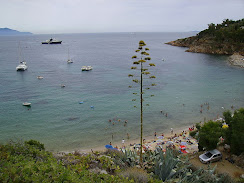Paolo Vaccari - rugby player
Italy’s second all-time highest try scorer
The rugby player Paolo Vaccari, who scored 22 tries for the Italian national team in a 64-cap career, was born on this day in 1971 in Calvisano, a town in Lombardy about 30km (19 miles) southeast of Brescia. A versatile back equally adept at wing, centre or full-back, Vaccari was regarded as a strong defender and an intelligent and technically-sound back who frequently created scoring opportunities for players around him. Although he was good enough to be selected for the renowned Barbarians invitational XV against Leicester Tigers in 1998, he played all his domestic rugby in Italy, enjoying great success. He won the double of Italian Championship and Cup with Milan Rugby in 1994-95 and was a title-winner for the second time with his home club Calvisano 10 years later, during a run in which Calvisano reached the Championship final six years in a row, from 2001-06. Vaccari had won his second Italian Cup medal with Calvisano in 2003-04. In international rugby, his proudest moment was undoubtedly scoring Italy’s fourth try in their historic 40-32 victory over reigning Five Nations champions France in the final of the FIRA Cup in Grenoble in 1997. Read more…
_________________________________________________________
Paolo Sarpi – writer and statesman
Patriotic Venetian who the Pope wanted dead
Historian, scientist, writer and statesman Paolo Sarpi died on this day in 1623 in Venice. He had survived an assassination attack 16 years before and was living in seclusion, still preparing state papers on behalf of Venice, writing, and carrying out scientific studies. The day before his death he had dictated three replies to questions about state affairs of the Venetian Republic. He had been born Pietro Sarpi in 1552 in Venice. His father died while he was still a child and he was educated by his uncle, who was a school teacher, and then by a monk in the Augustinian Servite order. He entered the Servite order himself at the age of 13, assuming the name of Fra Paolo. After going into a monastery in Mantua, he was invited to be court theologian to Duke Guglielmo Gonzaga. He then went to Milan, where he was an adviser to Charles Borromeo, the archbishop of Milan, before being transferred back to Venice to be professor of philosophy at the Servite convent. At the age of 27, Sarpi was sent to Rome, where he interacted with three successive popes. He then returned to Venice, where he spent 17 years studying. Read more…
__________________________________________________________
Gigi Radice - football coach
Former Milan player steered Torino to only title in 73 years
Luigi 'Gigi' Radice, the only coach to have won the Italian football championship with Torino in the 73 years that have elapsed since the Superga plane crash wiped out the greatest of all Torino teams, was born on this day in 1935 in Cesano Maderno, near Monza, some 24km (15 miles) north of Milan. An attacking full-back with AC Milan, where he won the Scudetto three times and was a member of the team that won the 1962-63 European Cup, Radice made five appearances for Italy, including two at the 1962 World Cup finals in Chile. He switched to coaching in 1965 after a serious knee injury ended his playing career prematurely and achieved immediate success with his local club, Monza, whom he guided to promotion as champions in Serie C. After leading Cesena to promotion to Serie A for the first time in the Emilia-Romagna club's history in 1972-73 Radice had spells with Fiorentina and Cagliari before Torino owner Orfeo Pianelli hired him in 1975. Torino had finished third in 1971-72 and in the top six in each of the following three seasons but were not close to breaking the dominance of city rivals Juventus. Read more…
____________________________________________________________
Giambattista De Curtis – songwriter and artist
Talented Neapolitan became captivated with the beauty of Sorrento
Writer, painter and sculptor Giambattista De Curtis died on this day in 1926 in Naples. A talented poet and playwright, he also wrote the lyrics for many popular songs. He is perhaps best known for the song Torna a Surriento, although the English words that have now become famous differ from the original verses for the song that he wrote in Neapolitan dialect. De Curtis is believed to have written the words for Torna a Surriento while on the terrace of the Imperial Hotel Tramontano in 1902, gazing out at the sea whose beauty he was praising. De Curtis lived for weeks at a time in the hotel and painted frescoes and canvases to decorate the walls for the owner, Guglielmo Tramontano, who was also Mayor of Sorrento at the time. One theory is that De Curtis was asked to write the song to mark the stay at the hotel of Italian Prime Minister Guiseppe Zanardelli. But another school of thought is that he had already written the words to accompany the beautiful music written by his brother, Ernesto, a few years earlier and that he revived it for the occasion. Torna a Surriento has often been performed and recorded with its original words, sung by such great performers as Giuseppe Di Stefano and Luciano Pavarotti. Read more…



































